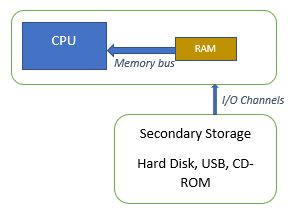Computer Storage has a come a long way from Babbage’s mill to magnetic tape medium to the ultra fast and sophisticated solid state drives of today.
Let’s take a deeper look into the different types of storage and how they impact the running of our computer.
Storage is one of the key components of a computer (the other 3 being Input, Output, and the Processor – CPU).
Storage is where data and programs are stored either short-term needed for immediate processing by the CPU or long-term for when needed at a later time.
There are two types of Storage – Primary and Secondary.

Primary Storage is also called MEMORY. It is used to store data needed quickly for actively running processes.
RAM or Random Access Memory is a type of primary storage.

Secondary storage is used for long term storage. It has to be loaded to Memory first for the CPU to use it.
Hard disk, USB drives are types of Secondary storage. (pic on right)
It’s like a Refrigerator, where you can store food long-term and bring it out to the table when needed. Anything on the dining table is for immediate consumption, rest get stored in the fridge.
How is Memory and Storage measured?
The smallest unit of memory is called a bit. It can store two values – 0 or 1. Or in electronic terms, Off or On. Say ‘a’ when Off and ‘b’ when On. But we have way more characters in our alphabets.
What if we grouped 2 bits as one unit? Now the representation possibility increases to 4 characters!! One character each represented by Off-Off, On-On, On-Off, and Off-On. But 4 is still not enough to represent all the characters possible. What if we grouped 3 bits as one unit?
ACTIVITY
Can you list all the On-Off possibilities with 3 bits? Let us get you started – off-off-off
Finally, the industry settled on a group of 8 bits as a unit to represent one character. With 28 = 256 combination possibilities, each could represent all of our numbers, alphabets, signs, etc. A set of 8 bits is called a byte.
One byte holds one character in memory. Memory and storage are measured in bytes.
1 bit = smallest unit of storage.
1 byte = 8 bits
1 KB (kilobyte) = 1024 bytes (210).
1 MB (megabyte) = 1000 KB.
1 GB (gigabyte) = 1000 MB.
1 TB (terabyte) = 1000 GB.
As you can see, terabytes of storage is a lot of storage that can hold a pretty good size of data and programs. Primary storage or main Memory is relatively small and usually holds several megabytes. Secondary storage can be HUGE and can go anywhere from a few megabytes to several terabytes.
Activity
Above, we used an analogy of a Refrigerator to describe secondary storage, and a dining table for Primary Storage.
Can the below pair of pictures be used as an analogy for Primary and Secondary Storage? If so, how?

Can you think of other analogies for Primary and Secondary storage?
If you have a file that is 3 MB in size, how many characters does it hold?
Is a 2 KB file larger or smaller than a 50 MB file?
